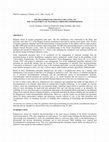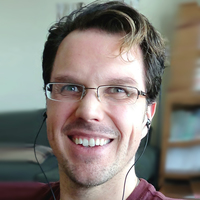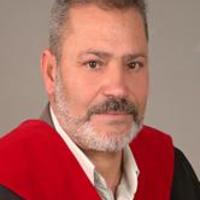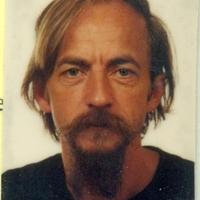Papers by Lucien Teunckens
ASME 2001 8th International Conference on Radioactive Waste Management and Environmental Remediation, Apr 24, 2020
Nuclear Engineering International, 1994
ASME 2001 8th International Conference on Radioactive Waste Management and Environmental Remediation, Apr 24, 2020

OSTI OAI (U.S. Department of Energy Office of Scientific and Technical Information), Feb 27, 2003
Belgium started its nuclear programme quite early. The first installations were constructed in th... more Belgium started its nuclear programme quite early. The first installations were constructed in the fifties, and presently, more than 55 % of the Belgian electricity production is provided by nuclear power plants. After 30 years of nuclear experience, Belgium started decommissioning of nuclear facilities in the eighties with two main projects: the BR3-PWR plant and the Eurochemic reprocessing plant. The BR3-decommissioning project is carried out at the Belgian Nuclear Research Centre, while the decommissioning of the former Eurochemic reprocessing plant is managed and operated by Belgoprocess n.v., which is also operating the centralised waste treatment facilities and the interim storage for Belgian radioactive waste. Some fundamental principles have to be considered for the management of materials resulting from the decommissioning of nuclear installations, equipment and/or components, mainly based on the guidelines of the "IAEA-Safety Fundamentals. The Principles of Radioactive Waste Management. Safety Series No. 111-F, IAEA, Vienna, 1995" with respect to radioactive waste management. Two of the fundamental principles indicated in this document are specifically dealing with the strategy for the management of materials from decommissioning, "Generation of radioactive waste shall be kept to the minimum practicable" (seventh principle), and "Radioactive waste shall be managed in such a way that it will not impose undue burdens on future generations" (fifth principle). Based on these fundamental principles, Belgoprocess has made a straightforward choice for a strategy with minimisation of the amount of materials to be managed as radioactive waste. This objective is obtained through the use of advanced decontamination techniques and the unconditional release of decontaminated materials. Unconditionally released materials are recycled, such as i.e., metal materials that are removed to conventional melting facilities, or are removed to conventional industrial disposal sites if they have no remaining value. In order to achieve these objectives, Belgoprocess uses techniques and equipment that enable the high degrees of decontamination to be obtained, while based on commercially available technology. As an example, for concrete surfaces, where the contamination has not penetrated deeply, significant improvement in operation efficiency was achieved when developing dry hand held and automated floor and wall shaving systems as an alternative for scabbling. As it was also shown that it is economically interesting to decontaminate metal components to unconditional release levels using dry abrasive blasting techniques, an industrial automated dry abrasive blasting unit was installed in the Belgoprocess central decontamination infrastructure. Moreover, a specific facility was developed and operations started for taking representative samples and monitoring concrete material in view of the final demolition and unconditional release of remaining structures of buildings after completing all dismantling and decontamination work. All activities are carried out within the regulations about decommissioning activities and the unconditional release of materials that are stipulated in a Royal Decree that was published on July 20, 2001.

Various European decommissioning projects have shown that there are substantial variations in cos... more Various European decommissioning projects have shown that there are substantial variations in cost estimates for individual installations. Studies to understand the reasons for these differences have been somewhat hampered by the fact that different types of cost estimation methods are used, having different data requirements. Although some uncertainty is inevitable in any costing method, an understanding of the costing methods used in particular projects is useful to avoid key uncertainties. Difficulties of understanding can be encountered and invalid conclusions drawn in making cost comparisons without regard to the context in which the various cost estimates were made. The above-mentioned difficulties are partly due to the lack of a standardised or generally agreedupon costing method that includes well structured and defined cost items and an established estimation method. Such a structure and method would be useful not only for project cost comparisons, but would also be a tool for a more effective cost management. The European Commission (EC), the International Atomic Energy Agency (IAEA), and the OECD/Nuclear Energy Agency (NEA) have all ongoing activities addressing various aspects of decommissioning and decommissioning costs. Based on these concurrent activities and common objectives, and on the advantages of standardised cost item definitions, the three organisations have agreed to jointly prepare and publish a standardised list of cost items and related cost definitions, for decommissioning projects. The work is being carried out by Belgoprocess n.v. in the framework of a shared-cost contract with the European Commission (Nuclear Fission Safety Programme 1994-1998). The paper presents the result of this cooperative work.
This paper discusses the release of redundant materials from nuclear sites as practiced in a few ... more This paper discusses the release of redundant materials from nuclear sites as practiced in a few countries within the OECD. The information background has been produced as part of a study being conducted by a Task Group on the recycling and reuse of material. Starting with a general survey of material that has been released, the paper goes on to describe the concept for melting for the recycling of metals and some specific case histories of material released from nuclear sites in Sweden and Belgium.
ASME 2001 8th International Conference on Radioactive Waste Management and Environmental Remediation, Apr 24, 2020

In the beginning of April, 1998, Belgoprocess started the large scale decommissioning of shutdown... more In the beginning of April, 1998, Belgoprocess started the large scale decommissioning of shutdown facilities at the former waste treatment department of the Belgian Nuclear Research Centre (SCK•CEN). In the second half of 2000, the decommissioning of a former open concrete storage pond was started. It has two parts, one with a volume of 200 m3, the other has a volume of 2 000 m3. In the past, the tanks were used as open cooling reservoir for the scrubber water of an incinerator for low level beta-gamma wastes. As a result, it contained some 126 Mg of sludges that were treated in a bituminisation facility. After emptying and rinsing of the tanks, samples were taken from the inner (brick) and the outer (concrete) wall to define the contamination levels in the material. It was found that the first layer of about one centimetre of the brick wall showed some radium contamination. Samples taken from the outer wall showed no contamination, which does not mean that the entire outer wall should be free of contamination. It was seen that the outer wall had some cracks, and there was no guarantee that a layer of bitumen in between the two walls was still in good condition. Also the top layer of the concrete bottom proved to be radium contaminated. The outer walls of the storage pond were supported by a thick layer of soil, which proved to contain some spots of contamination. The contaminated soil was segregated and evacuated, the remaining part was removed to a temporary storage area, waiting to be monitored for final unconditional release. The paper gives an overview of the decommissioning activities relating to the open concrete storage pond at the former waste treatment department of the Belgian Nuclear Research Centre (SCK•CEN).

<jats:title>Abstract</jats:title> <jats:p>When decommissioning nuclear installa... more <jats:title>Abstract</jats:title> <jats:p>When decommissioning nuclear installations, large quantities of metal components are produced as well as significant amounts of other radioactive materials, which mostly show low surface contamination. Having been used or having been brought for a while in a controlled area marks them as 'suspected material'. In view of the very high costs for radioactive waste processing and disposal, alternatives have been considered, and much effort has gone to recycling through decontamination, melting and unconditional release of metals.</jats:p> <jats:p>In a broader context, recycling of materials can considered to be a first order ecological priority in order to limit the quantities of radioactive wastes for final disposal and to reduce the technical and economic problems involved with the management of radioactive wastes. It will help as well to make economic use of primary material and to conserve natural resources of basic material for future generations.</jats:p> <jats:p>In a demonstration programme, Belgoprocess has shown that it is economically interesting to decontaminate metal components to unconditional release levels using dry abrasive blasting techniques, the unit cost for decontamination being only 30% of the global cost for radioactive waste treatment, conditioning, storage and disposal. As a result, an industrial dry abrasive blasting unit was installed in the Belgoprocess central decontamination infrastructure.</jats:p> <jats:p>At the end of May 2001, after 6 years of operation, 523 Mg of contaminated metal has been treated. 182 Mg of this material was unconditionally released, having been monitored twice by the in-house health physics department. About 303 Mg of the metal, presenting surfaces that could not be measured due to their shape, were melted for unconditional release in a controlled melting facility. The suitability of the abrasive blasting system was verified, and it was proved that there was no intrusion of contamination into the material surface. The paper gives an overview of the experience relating to the decontamination of metal material by abrasive blasting at the decommissioning of the Eurochemic reprocessing plant in Dessel, Belgium.</jats:p>
<jats:title>Abstract</jats:title> <jats:p>Belgium started its nuclear programme... more <jats:title>Abstract</jats:title> <jats:p>Belgium started its nuclear programme quite early. The first installations were constructed in the fifties, and presently, more than 55% of the Belgian electricity production is provided by nuclear power plants. After 30 years of nuclear experience, Belgium started the decommissioning of nuclear facilities in the eighties with two main projects: the BR3-PWR plant and the Eurochemic reprocessing plant. The BR3-decommissioning project is carried out at the Belgian Nuclear Research Centre, while the decommissioning of the former Eurochemic reprocessing plant is managed and operated by Belgoprocess n.v., which is also operating the centralised waste treatment facilities and the interim storage for Belgian radioactive waste.</jats:p>

<jats:title>Abstract</jats:title> <jats:p>Belgoprocess started the industrial d... more <jats:title>Abstract</jats:title> <jats:p>Belgoprocess started the industrial decommissioning of the main process building of the former EURO-CHEMIC reprocessing plant in 1990, after completion of a pilot project in which two buildings were emptied and decontaminated to background levels. The remaining structures were demolished and the concrete debris was disposed of as industrial waste and green field conditions restored.</jats:p> <jats:p>Decommissioning involves the removal and decontamination of equipment from each cell, the decontamination of the cell walls, ceilings and floors, and the dismantling of the ventilation system. These activities are followed by a complete monitoring in order to obtain the unconditional release of the remaining structures.</jats:p> <jats:p>In the earlier days, concrete walls with limited in depth contamination, were decontaminated using commercially available pneumatic hand scabblers. In addition, 3-headed, 5-headed and 7-headed hand-operated floor scabblers have been used. The pneumatic powered machines have adapted dust extraction systems around the scabbier heads. To improve the working conditions for the operators, and to increase capacity, scabblers have been progressively automised.</jats:p> <jats:p>Operation efficiency was significantly improved when shaving machines were introduced, using a diamond tipped rotary head, designed to give a smooth surface finish, which is easier to measure. The use of these machines resulted in a higher efficiency and a 30% reduction of secondary waste production. It also reduced the physical load to the operators due to the absence of machine vibration.</jats:p> <jats:p>The paper gives an overview of the specific efforts that have been put in improving the techniques for the decontamination of concrete surfaces at the decommissioning of the Eurochemic reprocessing plant in Dessel, Belgium.</jats:p>
Afstudeerwerk ingediend tot het behalen van de wettelijke graad van burgerlijk elektrotechnisch i... more Afstudeerwerk ingediend tot het behalen van de wettelijke graad van burgerlijk elektrotechnisch ingenieur, richting zwakstroom

9th ASME International Conference on Radioactive Waste Management and Environmental Remediation: Volumes 1, 2, and 3, 2003
Various international and national bodies such as the International Atomic Energy Agency, the Eur... more Various international and national bodies such as the International Atomic Energy Agency, the European Commission, the US Nuclear Regulatory Commission have put forward proposals or guidance documents to regulate the "clearance" from regulatory control of very low level radioactive material, in order to allow its recycling as a material management practice. All these proposals are based on predicted scenarios for subsequent utilisation of the released materials. The calculation models used in these scenarios tend to utilise conservative data regarding exposure times and dose uptake as well as other assumptions as a safeguard against uncertainties. None of these models has ever been validated by comparison with the actual real life practice of recycling. An international project was organised in order to validate some of the assumptions made in these calculation models, and, thereby, better assess the radiological consequences of recycling on a practical large scale. The validation was proposed to be carried out by comparing the results of dose measurements during a chain of recycling operations to dose values calculated for the same operations using the (US) RESRAD-RECYCLE and the (French) CERISE programmes. The operations were to cover all recycling activities, including the receipt of contaminated scrap at the radiologically controlled melting facility, its segmentation and melting, transport of released ingots to a manufacturing industry for use with other scrap as feed material and production of industrial products (rolls). The project was initiated by the Swedish Radiation Protection Institute and was a cooperation between authorities, research institutes and commercial companies from Sweden, France, USA and Belgium. A first phase of melting of contaminated scrap at Studsvik, release of ingots and transport to Åkers was carried out. The ingots were re-melted along with other (uncontaminated) scrap at Åkers to be used for manufacturing rolls. The doses to workers were measured at Studsvik, Åkers and during ingot transport. Dose calculations were made in parallel with these operations using the RESRAD-RECYCLE and CERISE programmes. However, the results of these calculations could not be compared with the corresponding values of doses taken by workers, because all of the doses were below the limit of detection. Due to this fact, a second phase was executed involving the segmenting and melting of a 3.4 t stainless steel fuel rack with an estimated activity concentration of over 150 Bq/g, mostly Co-60.

Volume 2: Mgmt. Low/Interm. Level Waste; Spent Fuel; Economics/Analyses for Waste Mgmt.; Radiological Characterization/Application Release Criteria; Panel Sessions; Solid Waste Reduction/Treatment; Current Activities in Central/Eastern Europe; Environmental Remediation Technology; LL/ILW; HLW/Spe..., 2001
In the beginning of April, 1998, Belgoprocess started the large scale decommissioning of shutdown... more In the beginning of April, 1998, Belgoprocess started the large scale decommissioning of shutdown facilities at the former waste treatment department of the Belgian Nuclear Research Centre (SCK•CEN). In the second half of 2000, the decommissioning of a former open concrete storage pond was started. It has two parts, one with a volume of 200 m3, the other has a volume of 2 000 m3. In the past, the tanks were used as open cooling reservoir for the scrubber water of an incinerator for low level beta-gamma wastes. As a result, it contained some 126 Mg of sludges that were treated in a bituminisation facility. After emptying and rinsing of the tanks, samples were taken from the inner (brick) and the outer (concrete) wall to define the contamination levels in the material. It was found that the first layer of about one centimetre of the brick wall showed some radium contamination. Samples taken from the outer wall showed no contamination, which does not mean that the entire outer wall sho...
In 1990, the decommissioning work of the main building of the Eurochemic reprocessing plant start... more In 1990, the decommissioning work of the main building of the Eurochemic reprocessing plant started. After 4 years of activity the present status of the decommissioning is described; the working strategy and planning are explained, the methods and techniques are exposed, the workforce organization is addressed and the present achievements are stated. A perspective is given how the further work will progress in order to reach the status of derestriction by the year 2002.

Within the framework of the “Co-ordination Network on Decommissioning of Nuclear Installations Pr... more Within the framework of the “Co-ordination Network on Decommissioning of Nuclear Installations Project (2005–2008)” funded by the European Community a first edition of EURSSEM has been developed to promote common understanding of key issues in the development of a strategy, implementation and execution of a programme to remediate radioactively contaminated sites. The objective of EURSSEM is to describe and provide a consistent consensus information and guidance on strategy, planning, implementation and execution of stakeholder involvement, performing, and assessing radiological soil surface and groundwater (final) status surveys to meet established dose- or risk-based release criteria, and/or remediation, restoration, reuse and stewardship objectives, while at the same time encouraging effective use of human, raw material and financial resources. To be able to provide a consistent guidance and leading practices to involved participants (stakeholders) in a remediation programme for radioactively contaminated sites, an extensive literature study has been performed to collect important documents that have been produced in this field by the International Atomic Energy Agency (IAEA), the SAFEGROUNDS Learning Network, Multi-Agency Radiation Survey and Site Investigation Manual (MARSSIM) and other national and international institutes. EURSSEM incorporates information provided in those and other documents to conduct all actions at radioactively contaminated and potentially radioactively contaminated sites and/or groundwater up to their release for restricted or unrestricted (re)use. Brief descriptions are provided about the background and the need for a document like EURSSEM, about key issues like stakeholder involvement and archiving for future referencing including the follow-up of the further development of EURSSEM.Copyright © 2009 by ASME
Nuclear Engineering International, 1994
This paper discusses the release of redundant materials from nuclear sites as practiced in a few ... more This paper discusses the release of redundant materials from nuclear sites as practiced in a few countries within the OECD. The information background has been produced as part of a study being conducted by a Task Group on the recycling and reuse of material. Starting with a general survey of material that has been released, the paper goes on to describe the concept for melting for the recycling of metals and some specific case histories of material released from nuclear sites in Sweden and Belgium.
In 1990, the decommissioning work of the main building of the Eurochemic reprocessing plant start... more In 1990, the decommissioning work of the main building of the Eurochemic reprocessing plant started. After 4 years of activity the present status of the decommissioning is described; the working strategy and planning are explained, the methods and techniques are exposed, the workforce organization is addressed and the present achievements are stated. A perspective is given how the further work will progress in order to reach the status of derestriction by the year 2002.











Uploads
Papers by Lucien Teunckens